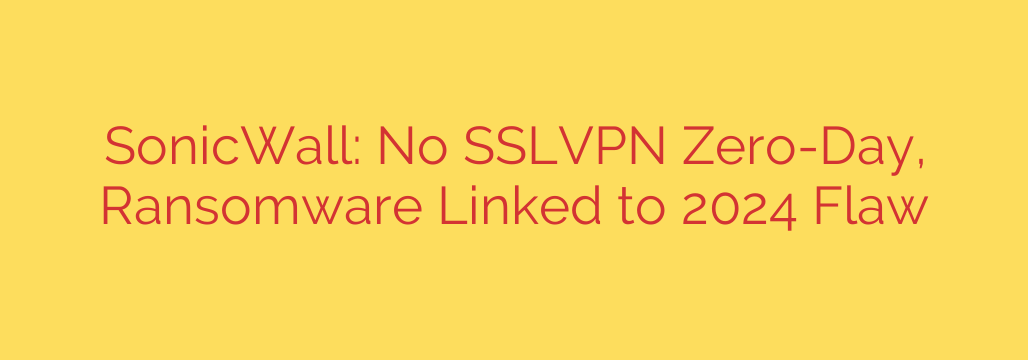
Understanding the Recent SonicWall Ransomware Attacks: It’s Not a Zero-Day
Recent chatter in the cybersecurity community has raised alarms about a potential new zero-day vulnerability affecting SonicWall devices. However, it’s crucial to clarify the situation: the ongoing ransomware attacks are not the result of a new or unknown exploit. Instead, threat actors are leveraging a previously disclosed and patched vulnerability from early 2024.
This distinction is critical for network administrators and security professionals. While the threat is severe, the defense against it is straightforward and relies on established security best practices.
The Real Threat: An Old Flaw Exploited
Security researchers have confirmed that the recent wave of attacks, attributed to the notorious Black Basta ransomware group, is exploiting known vulnerabilities in unpatched SonicWall Secure Mobile Access (SMA) appliances. The primary method of attack involves using stolen credentials to gain access to devices that have not been updated with the security patches released in February and March 2024.
The core issue is not a sophisticated new bypass, but rather a failure to apply timely security updates. Threat actors are systematically scanning for and targeting vulnerable, internet-facing devices that have been left unpatched, making them easy targets for unauthorized access and ransomware deployment.
Key takeaway: The attacks are succeeding by targeting organizations that have not yet applied critical patches that have been available for several months.
How the Attack Unfolds
The attack chain observed in these incidents is a classic example of exploiting weak security hygiene:
- Initial Access: The attackers identify unpatched SonicWall SMA devices.
- Credential Abuse: They use stolen or weak credentials to successfully log into the vulnerable appliance.
- Lateral Movement: Once inside the network, they move laterally to access critical systems and data.
- Ransomware Deployment: The Black Basta ransomware is deployed, encrypting files and disrupting operations.
This highlights a two-pronged security failure: an unpatched system and compromised credentials. Addressing either one of these issues could have prevented a successful breach.
Actionable Security Measures to Protect Your Network
Protecting your organization from this specific threat campaign requires a proactive and layered security approach. If you manage SonicWall appliances, taking the following steps immediately is essential.
1. Patch Your Devices Immediately
This is the most critical step. The vulnerabilities being exploited were addressed by SonicWall earlier this year. Ensure your SMA 100 series appliances are updated with the latest firmware. If you have not patched since February 2024, your systems are considered highly vulnerable.
2. Enforce Multi-Factor Authentication (MFA)
The attackers are relying on stolen credentials to gain access. Enforcing MFA on all user and administrative accounts is one of the single most effective defenses against this tactic. Even if an attacker has a valid username and password, they will be stopped from logging in without the second authentication factor.
3. Reset All Credentials
Out of an abundance of caution, it is highly recommended to reset the passwords for all users who access the SMA appliance. This includes local database users and any accounts integrated via LDAP or RADIUS. Prioritize resetting all administrative credentials.
4. Review and Audit Access Logs
Proactively monitor your device’s access logs for any signs of suspicious activity. Look for unusual login times, logins from unrecognized geographic locations, or multiple failed login attempts. These can be early indicators of an attack in progress.
5. Limit Management Interface Exposure
As a general security best practice, you should never expose your device’s management interface to the public internet. Access should be restricted to a secure, internal network segment. This drastically reduces the attack surface available to external threat actors.
While the news of a zero-day is always alarming, this situation serves as a powerful reminder that mastering the fundamentals of cybersecurity—timely patching, strong credential policies, and MFA—remains our best defense against the vast majority of threats. The risk from the Black Basta ransomware group is real, but it is a manageable one for organizations that prioritize proactive security maintenance.
Source: https://www.bleepingcomputer.com/news/security/sonicwall-finds-no-sslvpn-zero-day-links-ransomware-attacks-to-2024-flaw/








